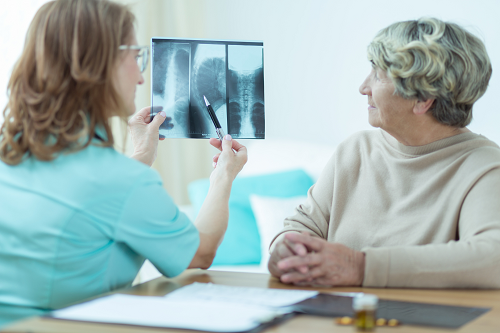
Them Bones, them Bones
Most women don’t worry about their bone health – that is, until something causes them to worry. But it’s crucial that we start thinking in terms of preventative health, rather than waiting for things to go wrong for us. And beyond just our weight and our wrinkles (in other words, what’s on the outside), but also the things we don’t see – such as our heart, their lungs and our bones – let’s not take them for granted ladies.
Because by the time the peri-menopause or menopause sets in (which can take place for some women as early as their 30s), the ‘demolition’ cells start working overtime and bone loss accelerates. This degeneration is frightening. It is our plummeting oestrogen levels, occuring during the menopause, which causes calcium to leak out of the bones.
Us women don’t just have hot flushes, sleeplessness or mood swings to deal with at this time of our lives; we could also be losing up to five per cent of our bone density every year for up to seven years after menopause – add that up over the years and you have a shocking statistic.
Replacing lost oestrogen through HRT has been proven to conserve bone density, but with some links between HRT and an increased risk of breast cancer highlighted a number of years ago, women are no longer being routinely prescribed the drug. Instead, it seems to be a matter of weighing up the risks with the possible benefits.
So What Can We Do To Safeguard Our Bone Health?
The great news is that, no matter what age you are or what your exercise history is, you have the ability to slow down the deterioration of your bones. Firstly, start eating more calcium-rich foods (or take a supplement if you’ve been recommended by your doctor to do so, particularly if he or she is concerned about your bone health).
Foods high in calcium aren’t just present in milk (which you may be limiting if you are on a weight loss plan and watching sugar as there is naturally occuring sugar in milk known as ‘lactose’). There are plenty of calcium-rich foods that many people are not aware of and these include greek yoghurt, sardines, dark leafy greens (such as kale and spinach), Brazil nuts and almonds. Avoid eating these calcium-rich foods (or taking your supplement) at the same time as an iron-rich food as this may affect your body’s absorption of the mineral.
Does Protein Help or Hinder?
The answer to this question is not simplistic. Basically, it’s the right amount of protein that matters. Too little, and research has shown us a correlation in the risk of fractures. In fact, higher protein status has been associated with shorter hospital stays, reduced mortality, reduced rate of complications after a hip fracture, and general attenuation of femoral bone loss in the elderly. Whereas an excessively high intake of protein is associated with increased urinary calcium excretion. And several research studies show that the countries with highest animal protein intakes are those with highest hip fracture rates. Confused? Don’t be – the answer is little and often.
In keeping with the guidelines form Motivation – of regular but moderate intakes of protein – you’ll be on the right track to better bone health. In fact, many clients find that, since they decrease their portion sizes when they join our programme, they are actually eating a little or a lot less protein (and significantly less carbohydrates and sugar). So the amount is not excessive. Also, if you are concerned about your bone health, consider looking towards sources of protein that are not animal-based for every meal (in other words, start to experiment with plant-based proteins once or twice a week, such as beans, pulses and lentils). See Jodie’s wonderful chickpea recipe here.
Time to Fit in Resistance
Next, take a look at the type, not just the amount, of exercise you take. Weight bearing exercise has been proven to be the best way to offset these problems, helping to keep your bones strong, while at the same time reducing the fat content of your body and increasing the amount of muscle mass you have (read our blog on the importance of strength training for weight control and overall health here.)
The key is to exercise regularly and vary the amount you do. The best route to take is to fit in some weight-training (or ‘resistance’ training, where you lift your own body weight) with some interval training or HIIT training (when you go ‘hell for leather’ for a few minutes, followed by a more relaxed pace, and then up the pace again for another few minutes – continued over a 20 or 30 minute period). This is also an excellent workout for the heart.
Many women are worried that they’ll ‘bulk up’ if they take up weights, but that doesn’t have to be the case at all. If you lift the correct weight for you, you won’t bulk up – instead, you’ll build lean muscle. Also, many women also think that weight lifting or other strength training is a young person’s sport. But that’s just a stereotype to be ignored as weight training can be so beneficial to the strength and overall ability to function in women aged 40, 50, 60 and beyond. In fact, I see lots of men and women in their 60s and 70s in my local gym and my own father (complete with two full knee-replacement) works out with a personal trainer once or twice a week.
The truth is, women often don’t put enough emphasis on using weights, thinking that this is the ‘men’s area’ of the gym, while they stay on the cross-trainer or stairmaster. However, strength training is hugely important for women, especially in later life, not only to avoid osteoporosis, but also stiffness, arthritis and other debilitating conditions. Also toning the muscles keeps them strong, healthy and lean, which has the added effect of keeping your weight down and helping to reduce the appearance of cellulite too.
*Always get advice from a professional before embarking on a strength programme.



